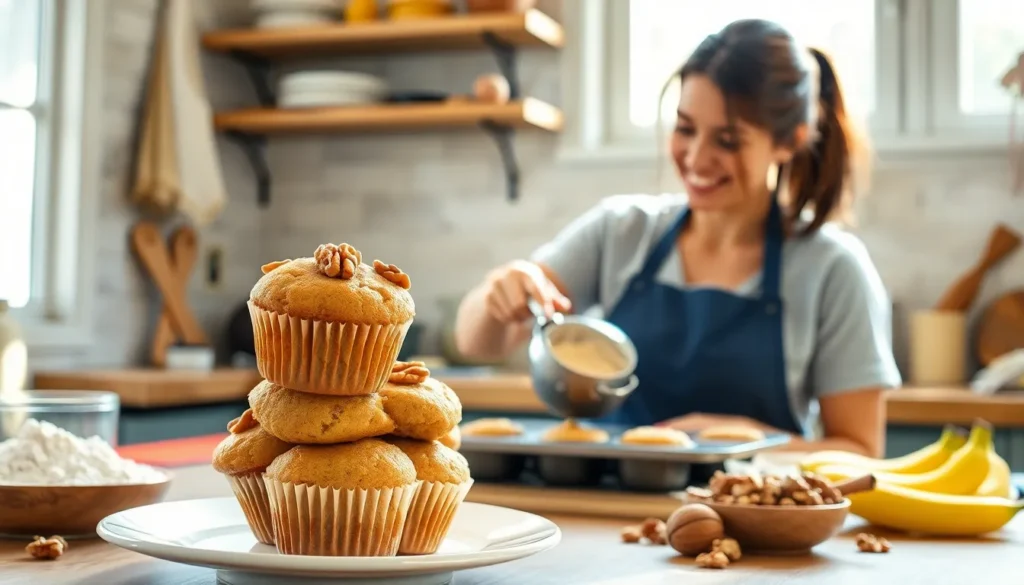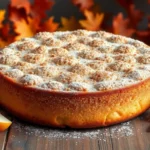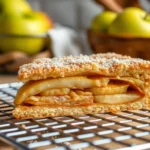Nothing beats the aroma of freshly baked banana nut muffins wafting through your kitchen on a weekend morning. These tender, moist treats combine the natural sweetness of ripe bananas with the satisfying crunch of toasted nuts, creating a perfect balance that’s captured hearts for generations. We’ve perfected this classic recipe to deliver bakery-quality results every single time.
What makes our banana nut muffins truly special is their incredible versatility. They’re equally at home on your breakfast table alongside a steaming cup of coffee or packed in lunch boxes for an afternoon energy boost. The secret lies in using perfectly ripened bananas – those brown-spotted beauties that might look past their prime are actually at their flavor peak.
We’ll show you how to transform simple pantry staples into golden, dome-topped muffins that’ll have your family asking for seconds. With our foolproof technique, you’ll master the art of creating muffins that are perfectly moist inside with just the right amount of nutty texture in every bite.
Ingredients
Creating perfect banana nut muffins starts with gathering the right ingredients in proper proportions. We’ve organized our ingredients by type to make your baking process smooth and efficient.
Dry Ingredients
- 2 cups all-purpose flour
- 3/4 cup granulated sugar
- 2 teaspoons baking powder
- 1/2 teaspoon salt
- 1/2 teaspoon ground cinnamon
- 1/4 teaspoon nutmeg
Wet Ingredients
- 3 large ripe bananas, mashed
- 1/3 cup melted butter, cooled slightly
- 1 large egg, room temperature
- 1 teaspoon vanilla extract
- 1/3 cup whole milk
Mix-Ins
- 3/4 cup chopped walnuts
- 2 tablespoons all-purpose flour (for coating nuts)
Equipment Needed

Before we begin mixing our banana nut muffin batter, gathering the right tools makes the entire baking process smooth and efficient. We need exact equipment to ensure our muffins turn out perfectly every time.
A standard 12-cup muffin tin serves as our primary baking vessel. This size accommodates the recipe yield while providing even heat distribution for consistent results. Paper muffin liners simplify removal and cleanup, preventing our delicate muffins from sticking to the pan.
Two large mixing bowls allow us to properly separate wet and dry ingredients before combining them. This technique prevents overmixing, which can lead to tough muffins. One bowl holds our flour mixture while the other contains our banana and liquid ingredients.
For preparing our bananas, we recommend either a potato masher or sturdy wooden spoon. These tools break down the fruit to the perfect consistency without creating a completely smooth puree. We want some small banana pieces for texture in our finished muffins.
A whisk or rubber spatula handles the final mixing stages. The whisk works well for combining wet ingredients, while the spatula excels at folding dry ingredients into the banana mixture without overworking the batter.
| Equipment Type | Exact Item | Purpose |
|---|---|---|
| Baking | 12-cup muffin tin | Primary baking vessel |
| Preparation | Paper muffin liners | Easy removal and cleanup |
| Mixing | 2 large bowls | Separate wet and dry ingredients |
| Mashing | Potato masher or wooden spoon | Prepare bananas |
| Combining | Whisk or rubber spatula | Mix ingredients properly |
Having these tools ready before we start ensures our banana nut muffins come together quickly and efficiently, maintaining the proper texture that makes them irresistibly moist and flavorful.
Instructions
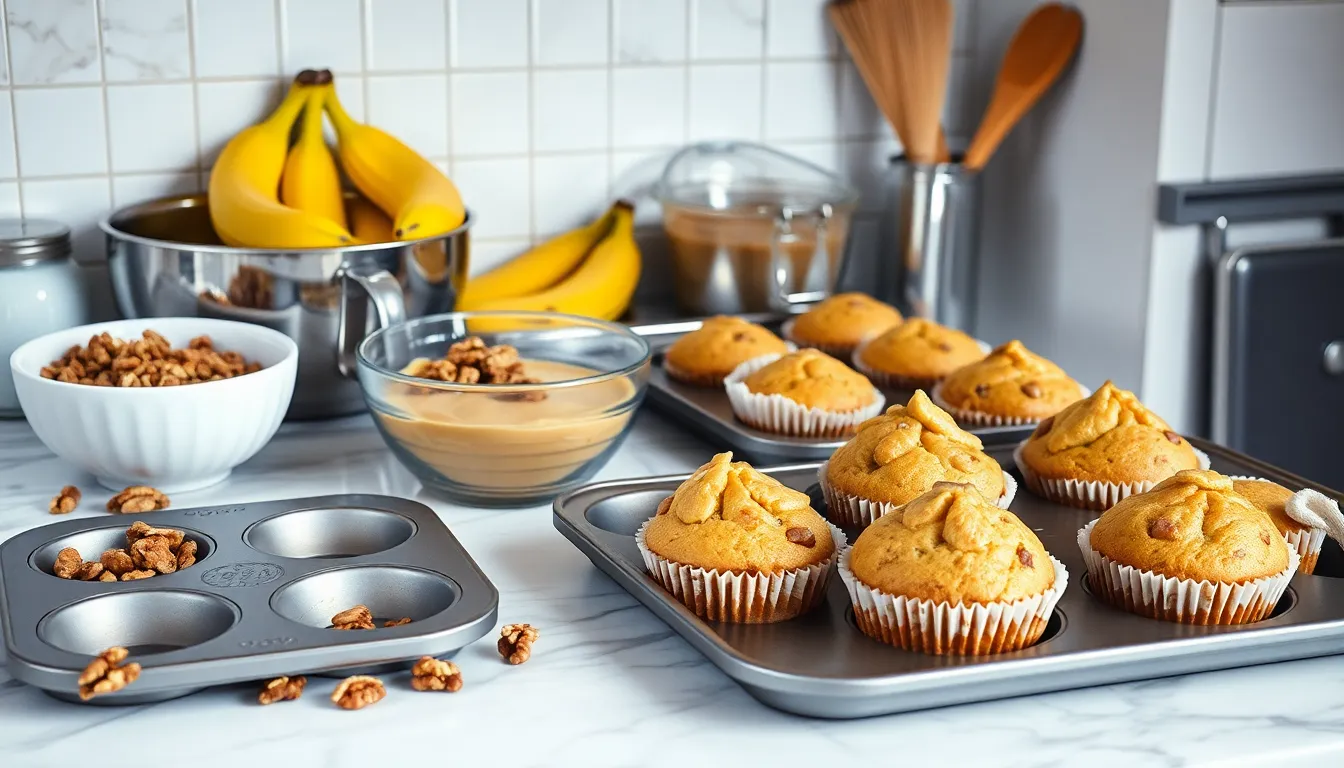
We’ll guide you through our step-by-step process to create perfectly moist banana nut muffins with that coveted bakery-style appearance. Our method incorporates research-backed techniques to ensure consistent results every time.
Prep Work
We start by preheating our oven to 425°F for the high-temperature method or 350°F for standard baking. Research shows that starting at higher temperatures creates those desirable tall muffin tops that bakeries achieve. Our muffin tin gets lined with paper liners or thoroughly greased to prevent any sticking issues.
Gathering our ripe bananas comes next – we need 4 to 6 large bananas to yield approximately 2 cups of mashed banana. We mash them until smooth for consistent texture throughout our muffins. Measuring the mashed banana amount ensures accuracy in our recipe results.
Mixing the Batter
We combine our mashed bananas with all wet ingredients in a large bowl: vegetable oil, melted butter, egg, and vanilla extract. Our dry ingredients get mixed separately in another bowl – all-purpose flour, sugar, baking powder, baking soda, cinnamon, salt, and nutmeg create the perfect flavor foundation.
Gradually adding the dry ingredients to our wet mixture prevents overmixing, which can result in tough muffins. We stir just until the ingredients combine, leaving some lumps for tender results. Our chopped walnuts get folded in using a gentle spatula motion to distribute them evenly.
Research suggests letting the batter rest for 15 to 30 minutes, which develops better flavor and improves texture. During this time, we prepare our optional nut topping by mixing chopped nuts, brown sugar, and melted butter.
Filling the Muffin Cups
We fill each muffin cup almost to the top with batter to achieve those impressive bakery-style heights. Our reserved nut topping or sanding sugar gets sprinkled over each cup for added texture and visual appeal.
Some baking techniques recommend filling only six cups at a time, using every other space for better air circulation. This method can result in more evenly baked muffins with superior rise.
Baking
We place our muffin tin in the center of the preheated oven for optimal heat distribution. Using the high-temperature method, we bake at 425°F for 7 minutes, then reduce to 350°F for 13 to 16 minutes until a toothpick inserted in the center comes out clean.
Standard baking at 350°F requires 18 to 20 minutes of baking time. We test for doneness by inserting a toothpick into the tallest muffin – it should emerge with just a few moist crumbs attached.
Our finished muffins need 10 to 15 minutes of cooling time in the pan before we remove them. This cooling period prevents the muffins from breaking apart and allows the structure to set properly.
Directions for Perfect Banana Nut Muffins
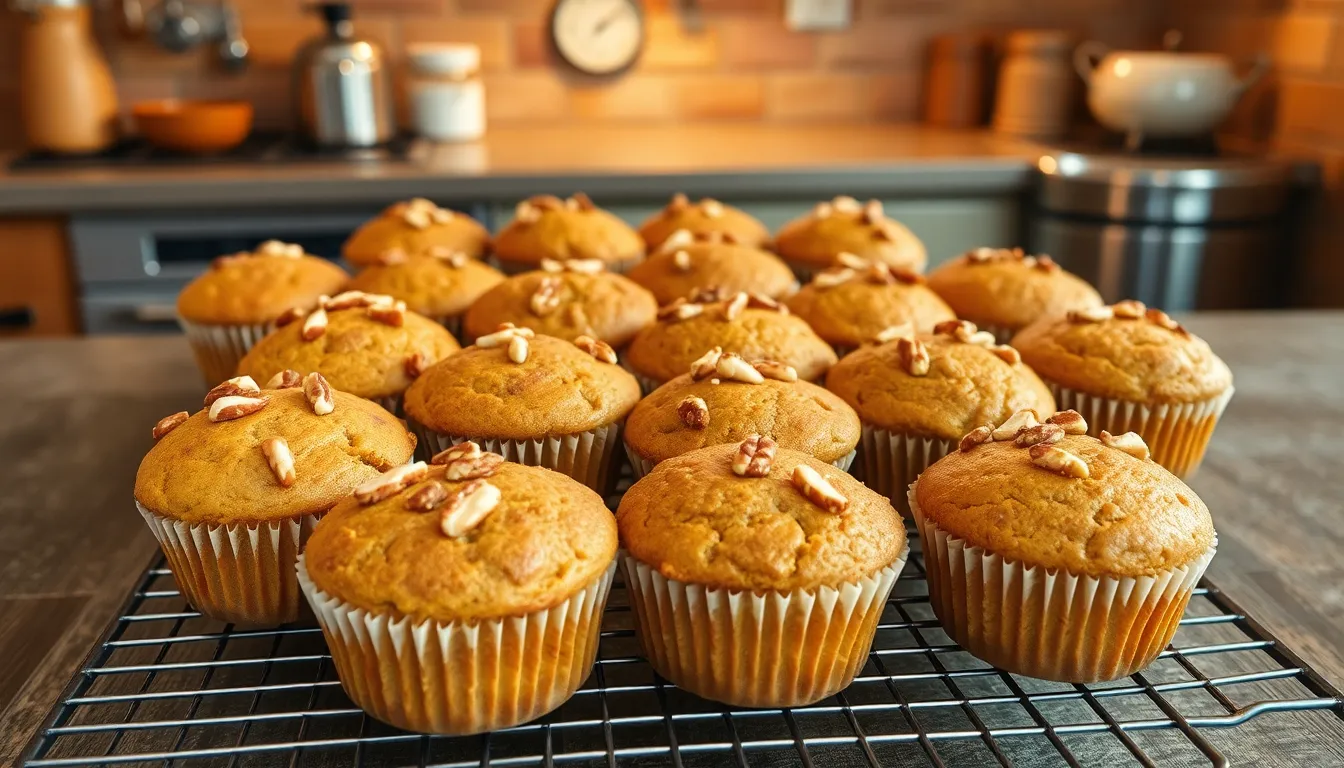
Now that we’ve prepared our batter and filled our muffin cups, let’s focus on the crucial final steps that ensure bakery-quality results. These techniques will guarantee perfectly baked muffins every time.
Testing for Doneness
We know our muffins are ready when several visual and tactile cues align perfectly. Insert a toothpick or thin knife into the center of a muffin to check for doneness. The tester should emerge clean or with just a few moist crumbs clinging to it, but never with wet batter.
Golden brown tops signal proper baking, while the surface should spring back when we gently touch it. Muffins will also pull slightly away from the sides of the pan when fully baked. The aroma becomes notably fragrant as they near completion.
Baking times typically range from 15 to 20 minutes, though we should rely more on visual cues than strict timing. Different oven temperatures and muffin sizes affect baking duration, so we always test the center muffin first since it takes longest to cook through.
Cooling and Storage
Proper cooling preserves the muffins’ tender crumb and prevents them from becoming soggy. We let muffins cool in the pan on a wire rack for 10 to 15 minutes before attempting removal. This resting period allows the structure to set while preventing the bottoms from becoming too moist.
After the initial cooling period, we transfer muffins to a wire rack to cool completely. Room temperature storage works best for immediate consumption, keeping muffins in an airtight container for up to 3 days.
| Storage Method | Duration | Best For |
|---|---|---|
| Room temperature (airtight container) | Up to 3 days | Immediate consumption |
| Refrigerated (airtight container) | Up to 1 week | Extended freshness |
| Frozen (freezer bags) | Up to 3 months | Long-term storage |
Refrigeration extends shelf life up to one week when we store them properly in airtight containers. For longer storage, we wrap individual muffins in plastic wrap before placing them in freezer bags, where they maintain quality for up to three months. Frozen muffins thaw beautifully at room temperature or can be warmed gently in a low oven.
Make-Ahead Tips

We understand the importance of planning ahead when it comes to baking delicious banana nut muffins. Strategic preparation allows us to enjoy fresh muffins whenever we want them without starting from scratch each time.
Batter Preparation in Advance
Our banana nut muffin batter benefits significantly from advance preparation. We recommend letting the mixed batter rest for 30 minutes before baking to achieve taller and fluffier results. The resting period allows the flour to fully hydrate while the leavening agents activate more effectively.
For even better results we can prepare the batter the night before. Simply cover the bowl tightly with plastic wrap and refrigerate overnight. This extended resting time develops deeper flavors while maintaining the perfect texture we desire.
Creating Make-Ahead Toppings
We can streamline our baking process by preparing the caramelized nut topping in advance. Mix chopped walnuts with flour, sugar, and cinnamon in a bowl. Add melted butter to create a crumbly mixture that stores beautifully in the refrigerator. This topping stays fresh and ready to sprinkle on our muffins whenever we bake.
Optimal Storage Answers
| Storage Method | Duration | Best Practices |
|---|---|---|
| Room Temperature | Up to 2 days | Store in airtight container or under dome |
| Refrigerator | 4-5 days | Use airtight container to prevent moisture loss |
| Freezer | 2-3 months | Wrap individually or use freezer bags |
Room temperature storage works perfectly for muffins we plan to consume within two days. We place cooled muffins in an airtight container or under a cake dome to maintain their soft texture.
Refrigerated storage extends freshness for up to five days when we use proper airtight containers. The cool environment prevents spoilage while preserving the moist crumb we love.
Freezing offers the longest storage option for our banana nut muffins. We wrap each cooled muffin individually in plastic wrap or place them in sealable freezer bags. This method prevents freezer burn while maintaining quality for up to three months.
Strategic Baking Temperature Approach
We achieve bakery quality results by starting with a high temperature approach. Preheat the oven to 425°F initially to create the perfect rise. After placing muffins in the oven reduce the temperature to 350°F or 400°F for the remaining baking time. This temperature technique gives us tall muffins with beautifully domed tops every time.
Variations and Substitutions
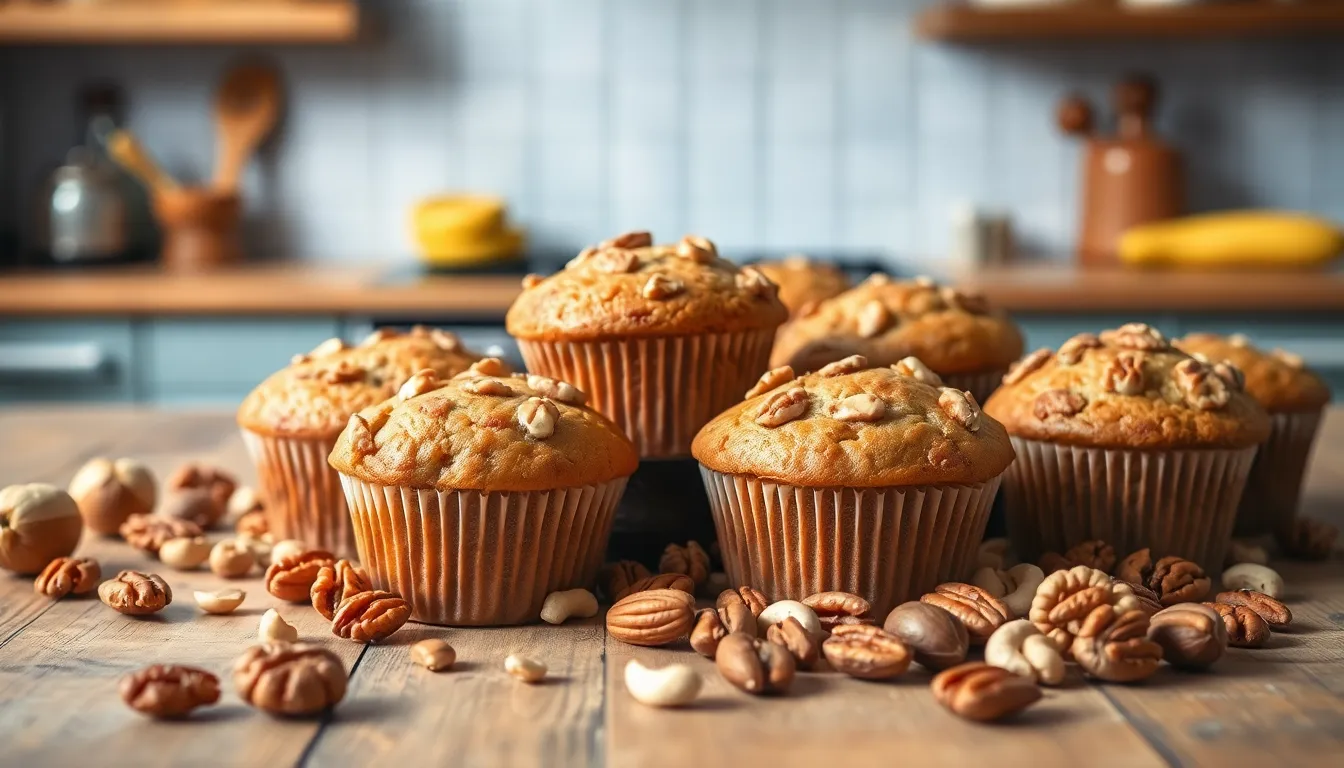
We love how adaptable banana nut muffins can be to suit different dietary needs and flavor preferences. These modifications allow everyone to enjoy our delicious recipe regardless of restrictions or taste preferences.
Different Nuts
While walnuts are the traditional choice for banana nut muffins, we can easily swap them for other varieties to create unique flavor profiles. Almonds bring a mild sweetness that pairs beautifully with banana, while pecans offer a rich buttery taste that elevates the overall experience. Cashews provide exceptional creaminess that melts seamlessly into each bite.
We can also mix different nuts together for complex textures and flavors that make each muffin interesting. Hazelnuts add a sophisticated European flair that transforms our basic recipe into something special. When using any of these alternatives, we chop them to similar sizes as walnuts and fold them gently into the batter or sprinkle them on top before baking for added crunch.
| Nut Type | Flavor Profile | Best Use |
|---|---|---|
| Almonds | Mild sweetness | Mixed into batter |
| Pecans | Buttery richness | Topping or mixed |
| Cashews | Creamy texture | Mixed into batter |
| Hazelnuts | Sophisticated nuttiness | Either application |
Gluten-Free Option
Creating gluten-free banana nut muffins requires replacing our all-purpose flour with a quality gluten-free flour blend. We recommend choosing blends that already contain xanthan gum, as this binding agent helps maintain the proper structure and texture we expect from our muffins.
If our chosen blend lacks xanthan gum, we add it ourselves using approximately 1/4 teaspoon per cup of flour. Certified gluten-free oats can replace part of the flour blend for added texture and fiber, but we ensure they’re truly certified to avoid cross-contamination concerns. The rest of our recipe remains unchanged, delivering the same moist and flavorful results.
Vegan Alternative
We can easily transform our banana nut muffins into a completely plant-based treat with simple substitutions. For each egg in our recipe, we mix 1 tablespoon of ground flaxseed or chia seeds with 3 tablespoons of water and let it sit for 5 minutes until it becomes gel-like.
Our butter gets replaced with an equal amount of neutral vegetable oil, melted coconut oil, or vegan butter for the same rich texture. When our recipe calls for dairy milk, almond milk or soy milk works perfectly as a one-to-one replacement. If we’re using sour cream in any variation, plant-based yogurt or unsweetened applesauce provides the same moisture and tanginess that makes our muffins irresistible.
Serving Suggestions

Our freshly baked banana nut muffins offer incredible versatility for any meal or occasion. We recommend serving them warm for the most aromatic experience, allowing the banana and nut flavors to shine through at their peak intensity.
Temperature and Timing
Thawed muffins require approximately 30 minutes at room temperature to reach optimal texture and taste, particularly when using individually wrapped varieties like those from Otis Spunkmeyer. We find that serving muffins at room temperature or slightly warmed creates the perfect balance of moistness and flavor release.
Meal Pairings
These delightful treats work beautifully as breakfast companions alongside your morning coffee, tea, or a tall glass of milk. We suggest creating balanced breakfast spreads by pairing banana nut muffins with savory items such as sausage bread or other baked breakfast favorites. Fresh fruit, creamy yogurt, or small protein dishes complement the muffins wonderfully while adding nutritional variety to your meal.
Creative Toppings
Enhance your muffins with extra chopped nuts sprinkled on top for added crunch and visual appeal. We love creating a special nut topping by tossing walnuts with honey and cinnamon, then sprinkling this mixture over the batter before baking. Dark chocolate chips make another excellent topping choice, adding rich sweetness that pairs beautifully with the banana base.
Storage and Reheating
| Storage Method | Duration | Best Practices |
|---|---|---|
| Room Temperature | Several days | Airtight container |
| Freezer | Up to 3 months | Individual wrapping |
| Reheating | As needed | Low oven temperature |
Our banana nut muffins maintain their quality when stored properly in airtight containers at room temperature. Frozen muffins can be reheated gently in a low oven, restoring their fresh-baked texture and aroma for extended enjoyment.
Storage Instructions
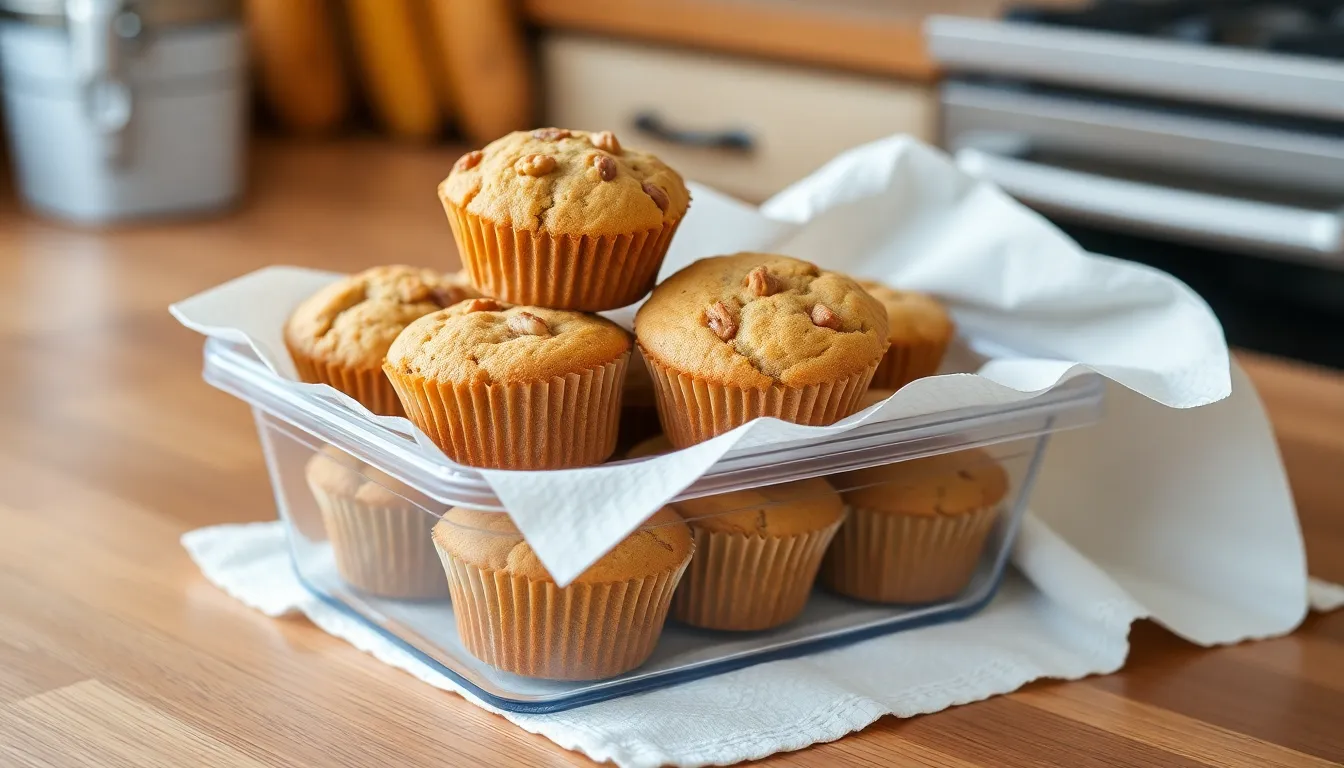
Proper storage keeps our banana nut muffins fresh and delicious for days or even months. We want to share the most effective methods to preserve their moist texture and rich flavor.
Room Temperature Storage
We can store freshly baked banana nut muffins at room temperature for 2 to 4 days when stored properly. Place the completely cooled muffins in an airtight container to maintain their moisture and prevent them from drying out. We recommend lining the container with a paper towel to absorb any excess moisture that could make the muffin bottoms soggy.
| Storage Method | Duration | Container Requirements |
|---|---|---|
| Room Temperature | 2-4 days | Airtight container with paper towel |
| Refrigeration | Up to 4 days | Airtight container |
| Freezer | Up to 2 months | Individually wrapped or freezer bag |
Refrigeration Storage
Refrigerating our banana nut muffins extends their freshness for up to 4 days. We store them in an airtight container in the refrigerator when we need to keep them longer than the room temperature timeframe allows. This method works particularly well in humid climates where room temperature storage might compromise quality sooner.
Freezer Storage
Freezing offers the longest storage option for our banana nut muffins, keeping them fresh for up to 2 months. We always cool the muffins completely before freezing to prevent ice crystals from forming. Each muffin should be wrapped individually in plastic wrap, or we can place them in a freezer-safe bag for bulk storage.
Thawing Methods
We have several effective options for thawing frozen muffins. Leaving them at room temperature for about an hour provides the most natural thawing process. We can also thaw them overnight in the refrigerator for gradual defrosting. For quick thawing, we wrap the muffin in a paper towel and microwave it in 15-second intervals, or we can wrap it in foil and bake at 350°F for 10 to 15 minutes.
Individually wrapped muffins that have been frozen and thawed can last up to 35 days when stored at room temperature, making them perfect for meal prep or extended storage needs.
Troubleshooting Tips
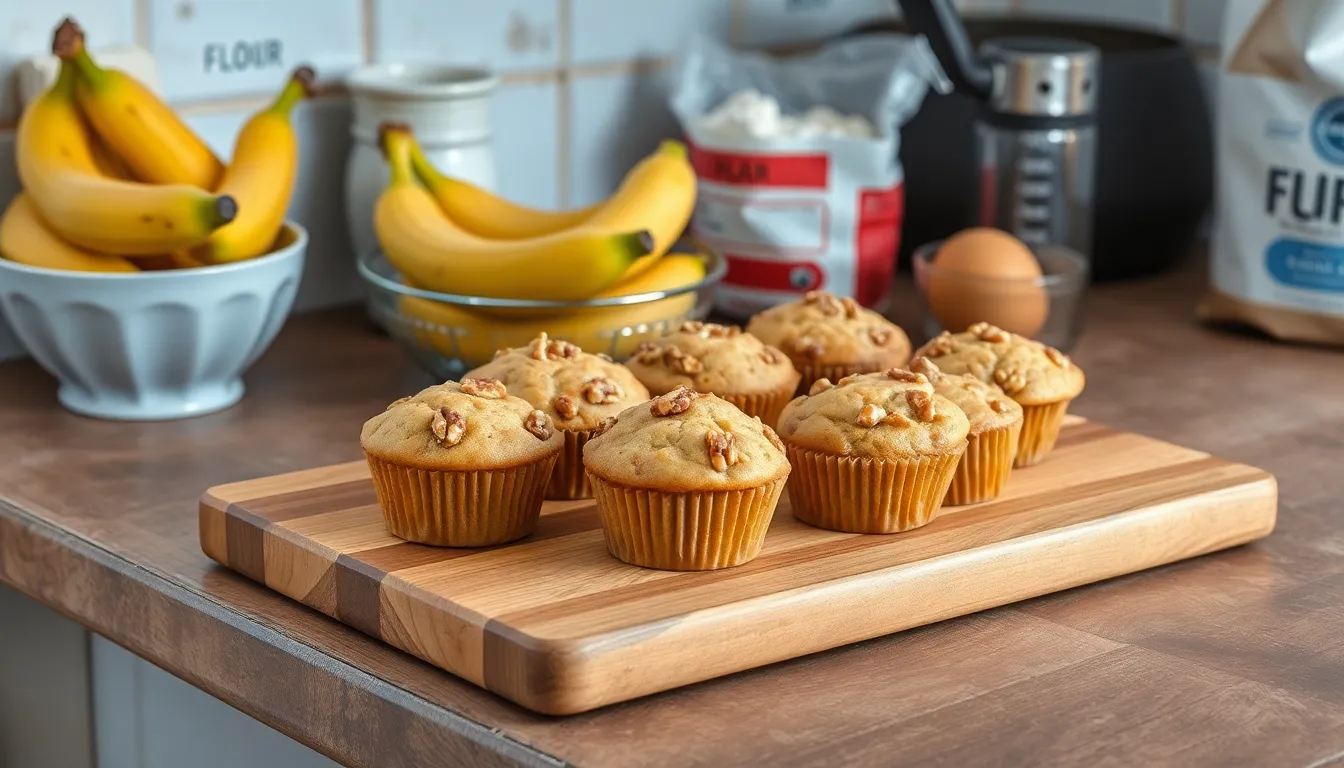
Even experienced bakers encounter challenges when making banana nut muffins. We’ve compiled the most common issues and their answers to help you achieve perfect results every time.
Ingredient Selection Problems
Dense or Heavy Muffins
Underripe bananas lack the natural sweetness and moisture needed for tender muffins. We recommend using ripened to almost overly ripened bananas for the best flavor and texture. Overly ripened bananas are sweeter and more suitable for baking than their firmer counterparts.
Cold Ingredients Creating Lumpy Batter
Room temperature ingredients blend more smoothly than cold ones. Ensure both buttermilk and eggs are at room temperature before mixing for a smoother batter. If your eggs are cold warm them in a mug with warm water for 10 minutes before using.
Mixing and Distribution Issues
Nuts Sinking to the Bottom
Walnuts often sink during baking if not properly prepared. To prevent walnuts from sinking mix them with the flour before adding the wet ingredients. This coating technique helps them distribute evenly throughout the muffin rather than settling at the bottom.
Tough or Dense Texture
Over-mixing creates tough muffins with a dense crumb. Mix wet and dry ingredients separately and gently fold them together until just combined. Visible flour streaks are acceptable since the batter will finish mixing during baking.
Baking Temperature and Timing Problems
Flat or Short Muffins
Low baking temperatures produce flat muffins without the coveted dome top. Bake at a high temperature such as 425°F to create tall and beautiful muffins. Fill muffin cavities 3/4 full to achieve tall muffins with a proper muffin top.
Dry or Crumbly Results
Standard all-purpose flour sometimes produces drier muffins than desired. Using bread flour can result in taller moister muffins due to its higher protein content. The extra protein creates better structure and moisture retention.
Banana-Related Issues
| Problem | Cause | Solution |
|---|---|---|
| Too heavy and damp | Excessive banana quantity | Use 4-6 large ripe bananas maximum |
| Lack of banana flavor | Underripe bananas | Choose bananas with brown spots |
| Uneven texture | Inconsistent mashing | Mash until smooth with small chunks |
Checking for Proper Doneness
Undercooked muffins collapse or have gummy centers while overcooked ones become dry. Always check if muffins are done by inserting a skewer into the center. If it comes out clean or with a few crumbs they are ready. The tops should spring back lightly when touched and appear golden brown.
Conclusion
We’ve equipped you with everything needed to create bakery-quality banana nut muffins that’ll become a household favorite. From selecting the ripest bananas to mastering proper mixing techniques you now have the confidence to bake consistently delicious results.
These versatile treats work beautifully for breakfast meal prep or afternoon snacks. With our storage tips and make-ahead strategies you can enjoy fresh muffins whenever cravings strike.
Remember that baking is both an art and science. Don’t be afraid to experiment with different nuts or try our suggested variations to make these muffins uniquely yours. Happy baking!
Frequently Asked Questions
What ingredients do I need for banana nut muffins?
You’ll need dry ingredients (all-purpose flour, granulated sugar, baking powder, salt, cinnamon, nutmeg) and wet ingredients (mashed ripe bananas, melted butter, egg, vanilla extract, whole milk). Don’t forget chopped walnuts for the signature nutty flavor. Using 4-6 large ripe bananas ensures the best taste and texture.
What equipment is essential for making banana nut muffins?
The key tools include a standard 12-cup muffin tin, paper muffin liners, two large mixing bowls, a potato masher or wooden spoon for bananas, and a whisk or rubber spatula for mixing. Having the right equipment ensures even baking and makes the process smoother and more efficient.
What’s the best baking temperature for banana nut muffins?
You can bake at either 425°F for a high-temperature method or 350°F for standard baking. The high-temperature method creates taller, bakery-style muffins with domed tops, while the standard temperature provides more even, consistent results. Both methods typically take 15-20 minutes.
How do I know when my banana nut muffins are done?
Insert a toothpick into the center of a muffin – it should come out clean or with just a few moist crumbs. Look for golden brown tops and a surface that springs back when lightly touched. Baking time is typically 15-20 minutes, but visual cues are more reliable than timing alone.
How should I store banana nut muffins?
Store at room temperature in an airtight container for up to 4 days, or refrigerate for up to 4 days for extended freshness. For long-term storage, freeze in freezer bags for up to 2 months. Individually wrapped frozen muffins can last up to 35 days at room temperature after thawing.
Can I make the batter ahead of time?
Yes! Let mixed batter rest for 30 minutes before baking for taller, fluffier muffins, or refrigerate overnight for deeper flavors. You can also prepare caramelized nut toppings in advance. This make-ahead approach actually improves the final texture and taste of your muffins.
What nuts can I substitute for walnuts?
You can use almonds, pecans, cashews, or hazelnuts to create different flavor profiles. Each nut brings its own unique taste and texture. Coat the nuts lightly in flour before mixing into the batter to ensure even distribution and prevent them from sinking to the bottom.
Can I make gluten-free or vegan banana nut muffins?
Absolutely! For gluten-free muffins, use a quality gluten-free flour blend. For vegan versions, substitute eggs with ground flaxseed or chia seeds, replace butter with vegetable oil or vegan butter, and use plant-based milk instead of dairy milk. These modifications maintain delicious results.
Why are my banana nut muffins dense or heavy?
Dense muffins usually result from overmixing the batter, using under-ripe bananas, or incorrect ingredient temperatures. Mix wet and dry ingredients separately, then combine just until incorporated. Use very ripe bananas and ensure ingredients are at room temperature for the best texture.
How do I prevent nuts from sinking to the bottom?
Coat chopped nuts lightly in flour before folding them into the batter. This helps them stay suspended throughout the muffin during baking. Also, don’t overmix the batter after adding nuts, as this can cause them to settle at the bottom of the muffin cups.

